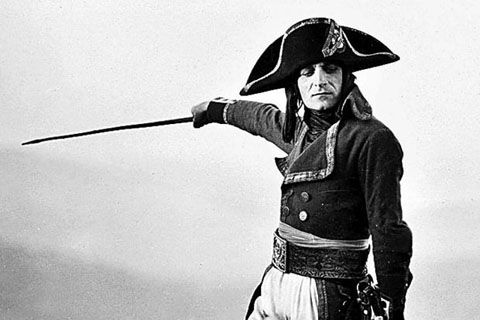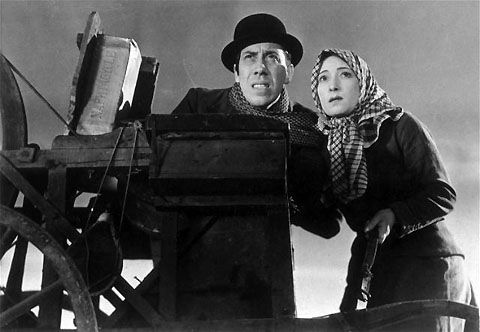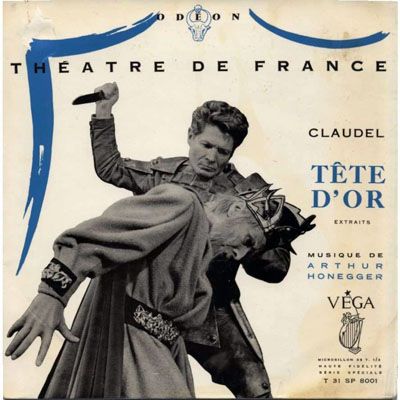wimpel69
03-20-2015, 12:45 PM
This is my own rip. To receive the FLAC link, please
reply in this thread. Personal messages will be ignored.
Limited sharing period. Includes artwork & booklet.
The chef d'ouevre of legendary French filmmaker Abel Gance, the 235-minute Napoleon
was supposed to have been the first installment in a multipart film study of the French
military hero Napol�on. Each of the film's set pieces is treated like a movie in itself:
the opening pillow fights and snowball battles, staged while Napoleon is still a schoolboy
(played by Russian youth Vladimir Roudenko), are choreographed on a scale worthy of
D.W. Griffith. The plot proper begins with Napoleon's adult years. From home island of
Corsica, Lt. Napoleon (played as an adult by Albert Dieudonn�, and old friend of Gance's)
decides to side with the Republic during the French Revolution. He quickly proves his
mettle in a preliminary skirmish with the British. Offered the office of commander of
Paris, Napoleon declines: he does not subscribe to Reign of Terror, nor does he believe
in doing battle against Frenchmen. He is thrown in prison, where he meets his wife-to-
be Josephine; thanks to a series of governmental upheavals, both are set free. For the
next few years, France's bureaucratic bean-counters and pencil-pushers constantly
thwart Napoleon's dreams of glory. The film's climax is Napoleon's rallying of the
dispirited French troops and his subsequent advance into Italy.
Originally Regain, this Marcel Pagnol masterwork was distributed in the US in
1939, two years after its completion; the hold-up was due to complaints from the New
York censors, who disapproved of the plotline's harmlessly adulterous undertones.
Told in a simple, straightforward fashion, the film deals with the trials and tribulations
of peasant farmer Panturie (Gabriel Gabrio) and his lover, apprentice knife-grinder
Arsule (Orane Demazis), as they struggle to revitalize their failing wheat farm. Despite
one setback after another, Panturie and Arsule refuse to give up, and it is their
devotion to their land-and each other-which sparks a revival of optimism and solidarity
throughout the countryside. Fernandel provides wistful comedy relief as Gedemus,
the itinerant knife-grinder to whom Arsule is married at the outset of the film.
Christian-Jacque's sole directorial effort for 1946 was Le Revenant, better known
to English-speaking audiences as A Lover's Return (though the title literally
translates as The Ghost). Jean-Jacques Sauvage (Louis Jouvet) plays a ballet impresario
who entices wealthy young Francois (Francois Perier) to leave home and join his ballet
company. Accustomed to playing with other people's lives, Jouvet also seduces and
abandons beautiful Genevieve (Gaby Morlay), his former lover, who resides in Francois'
hometown. French ballet artist Ludmilla Tcherina is prominently featured in the dance
sequences. Two years later, Tcherina was "officially" discovered for films in Powell
and Pressburger's The Red Shoes.
T�te d'Or and La R�demption de Fran�ois Villon are two scores that
Arthur Honegger wrote for radio plays.

Music Composed by
Arthur Honegger
Played by the
Jeune Orchestre Symphonique de Douai
Conducted by
Henri Vachey
Tracks 01-04: Un revenant - Suite (8'49)
Tracks 05-13: T�te d'Or - Suite (17'26)
Tracks 14-18: Regain - Suite (14'39)
Tracks 19-20: La R�demption de Francois Villon - Suite (06'04)
Tracks 21-28: Napol�on - Suite (20'57)
Total Time: 68'05


"Arthur Honegger, (born March 10, 1892, Le Havre, France—died Nov. 27, 1955, Paris), composer
associated with the modern movement in French music in the first half of the 20th century.
Born of Swiss parents, Honegger spent most of his life in France. He studied at the Z�rich
Conservatory and after 1912 at the Paris Conservatory. After World War I he was associated
with Les Six, a group of young composers that also included Georges Auric, Germaine Tailleferre,
Francis Poulenc, Darius Milhaud, and Louis Durey. Honegger soon asserted his own strong
personality in the “dramatic psalm” Le Roi David (1921; “The King David”). Two successful
orchestral works followed: Pacific 231 (1924), an impression of a locomotive in action, and
Rugby (1928), which reflected the composer’s love of speed and virile sports. Also from this
period was the Pastorale d’�t� (1921; “Summer Pastoral”) for chamber orchestra. Much—
but not all—of his music from the 1920s is rhythmic, dissonant, and austere and shows
great freedom in the treatment of tonality. Polytonality sometimes occurs. With his
dramatic oratorios Jeanne d’Arc au b�cher (“Joan of Arc at the Stake”) and La Danse
des morts (“The Dance of the Dead”), both on texts by Paul Claudel, he turned toward
the mysticism and religious meaning that underlie many of his later works.
Honegger was a prolific composer and made notable contributions to opera (Judith,
1926; Antigone, 1927; Amphion, 1931), ballet (Skating Rink, 1922; S�miramis, 1934),
choral music (oratorios, including Cantique des cantiques, 1938), and orchestral music
(five symphonies, symphonic poems, symphonic movements). His chamber music
includes three string quartets and sonatas for violin, viola, and cello. He also composed
the music for several films, including La Roue (1922; “The Wheel”), Pygmalion (1938),
and Cavalcade d’amour (1939). Honegger’s music is written in a bold and uninhibited
musical idiom that combines the harmonic innovations of the French avant-garde
with the large forms and massed sonorities of the German tradition. He published
an autobiography, Je suis compositeur (I Am a Composer), in 1951."

Original LP of T�te d'Or.

Honegger (right) with Abel Gance (Napol�on).
This is my own rip. To receive the FLAC link, please
reply in this thread. Personal messages will be ignored.
Limited sharing period. Includes artwork & booklet.
Source: Solstice CD (My rip!)
Format: FLAC (RAR), DDD Stereo, Level: -5
File Size: 340 MB (incl. cover & booklet)
Please buy the original. Do not share further. "Likes" are welcome! :)
reply in this thread. Personal messages will be ignored.
Limited sharing period. Includes artwork & booklet.
The chef d'ouevre of legendary French filmmaker Abel Gance, the 235-minute Napoleon
was supposed to have been the first installment in a multipart film study of the French
military hero Napol�on. Each of the film's set pieces is treated like a movie in itself:
the opening pillow fights and snowball battles, staged while Napoleon is still a schoolboy
(played by Russian youth Vladimir Roudenko), are choreographed on a scale worthy of
D.W. Griffith. The plot proper begins with Napoleon's adult years. From home island of
Corsica, Lt. Napoleon (played as an adult by Albert Dieudonn�, and old friend of Gance's)
decides to side with the Republic during the French Revolution. He quickly proves his
mettle in a preliminary skirmish with the British. Offered the office of commander of
Paris, Napoleon declines: he does not subscribe to Reign of Terror, nor does he believe
in doing battle against Frenchmen. He is thrown in prison, where he meets his wife-to-
be Josephine; thanks to a series of governmental upheavals, both are set free. For the
next few years, France's bureaucratic bean-counters and pencil-pushers constantly
thwart Napoleon's dreams of glory. The film's climax is Napoleon's rallying of the
dispirited French troops and his subsequent advance into Italy.
Originally Regain, this Marcel Pagnol masterwork was distributed in the US in
1939, two years after its completion; the hold-up was due to complaints from the New
York censors, who disapproved of the plotline's harmlessly adulterous undertones.
Told in a simple, straightforward fashion, the film deals with the trials and tribulations
of peasant farmer Panturie (Gabriel Gabrio) and his lover, apprentice knife-grinder
Arsule (Orane Demazis), as they struggle to revitalize their failing wheat farm. Despite
one setback after another, Panturie and Arsule refuse to give up, and it is their
devotion to their land-and each other-which sparks a revival of optimism and solidarity
throughout the countryside. Fernandel provides wistful comedy relief as Gedemus,
the itinerant knife-grinder to whom Arsule is married at the outset of the film.
Christian-Jacque's sole directorial effort for 1946 was Le Revenant, better known
to English-speaking audiences as A Lover's Return (though the title literally
translates as The Ghost). Jean-Jacques Sauvage (Louis Jouvet) plays a ballet impresario
who entices wealthy young Francois (Francois Perier) to leave home and join his ballet
company. Accustomed to playing with other people's lives, Jouvet also seduces and
abandons beautiful Genevieve (Gaby Morlay), his former lover, who resides in Francois'
hometown. French ballet artist Ludmilla Tcherina is prominently featured in the dance
sequences. Two years later, Tcherina was "officially" discovered for films in Powell
and Pressburger's The Red Shoes.
T�te d'Or and La R�demption de Fran�ois Villon are two scores that
Arthur Honegger wrote for radio plays.

Music Composed by
Arthur Honegger
Played by the
Jeune Orchestre Symphonique de Douai
Conducted by
Henri Vachey
Tracks 01-04: Un revenant - Suite (8'49)
Tracks 05-13: T�te d'Or - Suite (17'26)
Tracks 14-18: Regain - Suite (14'39)
Tracks 19-20: La R�demption de Francois Villon - Suite (06'04)
Tracks 21-28: Napol�on - Suite (20'57)
Total Time: 68'05


"Arthur Honegger, (born March 10, 1892, Le Havre, France—died Nov. 27, 1955, Paris), composer
associated with the modern movement in French music in the first half of the 20th century.
Born of Swiss parents, Honegger spent most of his life in France. He studied at the Z�rich
Conservatory and after 1912 at the Paris Conservatory. After World War I he was associated
with Les Six, a group of young composers that also included Georges Auric, Germaine Tailleferre,
Francis Poulenc, Darius Milhaud, and Louis Durey. Honegger soon asserted his own strong
personality in the “dramatic psalm” Le Roi David (1921; “The King David”). Two successful
orchestral works followed: Pacific 231 (1924), an impression of a locomotive in action, and
Rugby (1928), which reflected the composer’s love of speed and virile sports. Also from this
period was the Pastorale d’�t� (1921; “Summer Pastoral”) for chamber orchestra. Much—
but not all—of his music from the 1920s is rhythmic, dissonant, and austere and shows
great freedom in the treatment of tonality. Polytonality sometimes occurs. With his
dramatic oratorios Jeanne d’Arc au b�cher (“Joan of Arc at the Stake”) and La Danse
des morts (“The Dance of the Dead”), both on texts by Paul Claudel, he turned toward
the mysticism and religious meaning that underlie many of his later works.
Honegger was a prolific composer and made notable contributions to opera (Judith,
1926; Antigone, 1927; Amphion, 1931), ballet (Skating Rink, 1922; S�miramis, 1934),
choral music (oratorios, including Cantique des cantiques, 1938), and orchestral music
(five symphonies, symphonic poems, symphonic movements). His chamber music
includes three string quartets and sonatas for violin, viola, and cello. He also composed
the music for several films, including La Roue (1922; “The Wheel”), Pygmalion (1938),
and Cavalcade d’amour (1939). Honegger’s music is written in a bold and uninhibited
musical idiom that combines the harmonic innovations of the French avant-garde
with the large forms and massed sonorities of the German tradition. He published
an autobiography, Je suis compositeur (I Am a Composer), in 1951."

Original LP of T�te d'Or.

Honegger (right) with Abel Gance (Napol�on).
This is my own rip. To receive the FLAC link, please
reply in this thread. Personal messages will be ignored.
Limited sharing period. Includes artwork & booklet.
Source: Solstice CD (My rip!)
Format: FLAC (RAR), DDD Stereo, Level: -5
File Size: 340 MB (incl. cover & booklet)
Please buy the original. Do not share further. "Likes" are welcome! :)